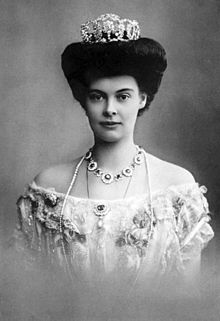This article needs additional citations for verification. (May 2022) |
| Cecilie of Mecklenburg-Schwerin | |||||
|---|---|---|---|---|---|
| German Crown Princess Crown Princess of Prussia | |||||
 | |||||
| Born | 20 September 1886 Schwerin, Mecklenburg-Schwerin, German Empire | ||||
| Died | 6 May 1954 (aged 67) Bad Kissingen, Bavaria, West Germany | ||||
| Burial | 12 May 1954 | ||||
| Spouse | |||||
| Issue | |||||
| |||||
| House | Mecklenburg-Schwerin | ||||
| Father | Frederick Francis III, Grand Duke of Mecklenburg-Schwerin | ||||
| Mother | Grand Duchess Anastasia Mikhailovna of Russia | ||||
Duchess Cecilie Auguste Marie of Mecklenburg-Schwerin (20 September 1886 – 6 May 1954) was the last German Crown Princess and Crown Princess of Prussia as the wife of Wilhelm, German Crown Prince, the son of Wilhelm II, German Emperor.
Cecilie was a daughter of Frederick Francis III, Grand Duke of Mecklenburg-Schwerin and Grand Duchess Anastasia Mikhailovna of Russia. She was brought up with simplicity, and her early life was peripatetic, spending summers in Mecklenburg and the rest of the year in Southern France. After the death of her father, she traveled every summer between 1898 and 1904 to her mother's native Russia. On 6 June 1905, she married German Crown Prince Wilhelm. The couple had four sons and two daughters. Cecilie, tall and statuesque, became popular in Germany for her sense of style. However, her husband was a womanizer and the marriage was unhappy.
After the fall of the German monarchy, at the end of World War I, Cecilie and her husband lived mostly apart. During the Weimar Republic and the Nazi period, Cecilie lived a private life mainly at Cecilienhof Palace in Potsdam. With the advance of the Soviet troops, she left the Cecilienhof in February 1945, never to return. She settled in Bad Kissingen until 1952 when she moved to an apartment in the Frauenkopf district of Stuttgart. In 1952, she published a book of memoirs. She died two years later.